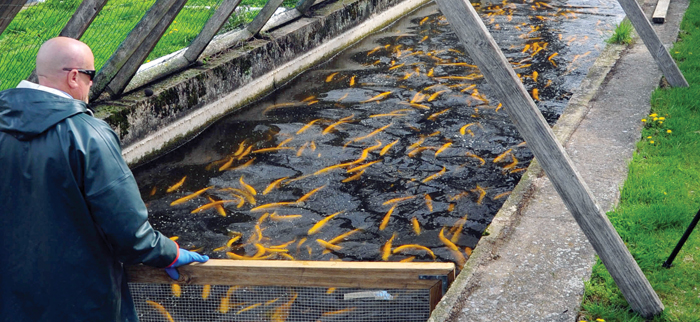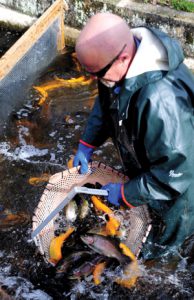From the Field: Marshall Brown, Cold Water Production Manager

Brown moves fish at Powell Hatchery; photo by Joe Evans
He’s an angler, hunter and general outdoorsman but for a living, he raises babies—baby fish that is. Marshall Brown and his team care for hundreds of thousands of trout each and every year in the state’s hatcheries, where eggs are raised through adulthood in order to stock waters throughout Maryland. Without stocking, some fish species might become depleted while others may not be able to thrive due to seasonal temperature variations.
Brown’s work cycle starts anew every fall, when multitudes of tiny eggs are delivered from Montana, Tennessee, Washington state and many others to his hatcheries: Bear Creek, Cushwalls, Mettiki and Powell. His first task is to disinfect the eggs and set them up in incubators, where they take 7-10 days to hatch. For a sense of perspective, more than 500,000 eggs hatch annually just at Powell!

photo by Joe Evans
After three weeks, they’re moved into circular hatch trays, where they start swimming and eating independently. This is the truly crucial time, just like caring for babies. Brown and his colleagues check water quality samples and feed them a special formula of fishmeal: a precise mix of proteins, fats, vitamins and minerals. By minimizing stress, the team hopes to keep the babies healthy so they can grow into full-size robust fish.
Usually, however, most of the fingerlings in his care grow into vigorous adults, ready for placement in streams and lakes throughout the state, which aids recreational fishing and boosts local economies through tourism. The state typically stocks about 400,000 brown and golden trout each spring and fall. Happy to do just that, Brown remarks, “We do this for [the anglers]. They buy their fish stamps, we want to supply the best fish we can. That’s where we get our satisfaction. Providing excellent customer service is our reward.”
Although it doesn’t happen often, sometimes the little ones don’t make it to adulthood. The worst loss Brown remembers occurred in 1996, when significant precipitation—including 2 feet of snow followed by a quick melt—caused major flooding at the Powell Hatchery. He recalls scores of tiny fish either lying dead in the grass or being washed away into nearby Beaver Creek, where they were likely eaten by bigger fish. “It was just so disheartening,” Brown says, “to have given them so much care and to have them all lost by a force of nature.”
| Cold water hatcheries produce various trout species for population enhancement and statewide put-and-take fishing opportunities, whereas warm water hatcheries produce other fish for corrective stocking in state reservoirs and other projects. |
Brown began his career 27 years ago at the warm water Unicorn Lake Hatchery as a fisheries technician. He later transferred to Powell, was promoted to facility manage and worked his way up to his current position managing the state’s cold water production.
Brown and his wife have four children and two grandchildren. They live just north of Hancock.
Article by Anna Lucente-Hoffmann—communications manager.
Appears in Vol. 20, No. 1 of the Maryland Natural Resource magazine, winter 2017.


 1-888-373-7888
1-888-373-7888 233733
233733